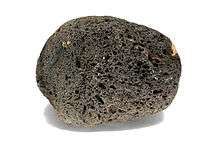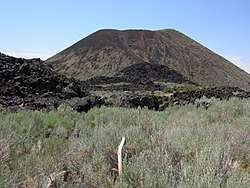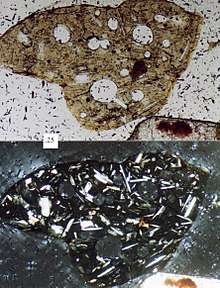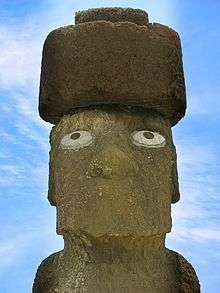Scoria
Scoria is a highly vesicular, dark colored volcanic rock that may or may not contain crystals (phenocrysts). It is typically dark in color (generally dark brown, black or purplish red), and basaltic or andesitic in composition. Scoria is relatively low in density as a result of its numerous macroscopic ellipsoidal vesicles, but in contrast to pumice, all scoria has a specific gravity greater than 1, and sinks in water. The holes or vesicles form when gases that were dissolved in the magma come out of solution as it erupts, creating bubbles in the molten rock, some of which are frozen in place as the rock cools and solidifies. Scoria may form as part of a lava flow, typically near its surface, or as fragmental ejecta (lapilli, blocks and bombs), for instance in Strombolian eruptions that form steep-sided scoria cones. Chemical analysis of scoria found in Yemen showed that it was mainly composed of volcanic glass with a few zeolites (e.g. clinoptilolite).[1] Most scoria is composed of glassy fragments, and may contain phenocrysts. The word scoria comes from the Greek σκωρία, skōria, rust. A colloquial term for scoria is cinder.[2][3]

Comparisons
Scoria differs from pumice, another vesicular volcanic rock, in having larger vesicles and thicker vesicle walls, and hence is denser. The difference is probably the result of lower magma viscosity, allowing rapid volatile diffusion, bubble growth, coalescence, and bursting.
Formation
As rising magma encounters lower pressures, dissolved gases are able to exsolve and form vesicles. Some of the vesicles are trapped when the magma chills and solidifies. Vesicles are usually small, spheroidal and do not impinge upon one another; instead they open into one another with little distortion.
Volcanic cones of scoria can be left behind after eruptions, usually forming mountains with a crater at the summit. An example is Maungarei in Auckland, New Zealand, which like Te Tatua-a-Riukiuta in the south of the same city has been extensively quarried. Quincan, a unique form of Scoria, is quarried at Mount Quincan in Far North Queensland, Australia.
Uses
Scoria has several useful characteristics that influence how it is used. It is somewhat porous, has a high surface area and strength for its weight, and often has striking colours. Consequently, it is often used in landscaping and drainage works.[4] It is also commonly used in gas barbecue grills.[5]
Scoria can be used for high-temperature insulation. It is also used on oil well sites to limit mud problems resulting from heavy truck traffic.
The quarry of Puna Pau on Rapa Nui/Easter Island was the source of a red-coloured scoria which the Rapanui people used to carve the pukao (or topknots) for their distinctive moai statues, and even to carve some moai themselves.
It is also used as a traction aid on ice- and snow-covered roads.
Images
 Fresh scoria sometimes has a blue sheen to its surface.
Fresh scoria sometimes has a blue sheen to its surface. Scoria of various hues exists on Mount Tarawera, from its 1886 eruption.
Scoria of various hues exists on Mount Tarawera, from its 1886 eruption. Holocene scoria-producing volcano near Veyo, Utah
Holocene scoria-producing volcano near Veyo, Utah Photomicrograph of a volcanic lithic fragment (sand grain) derived from scoria; upper picture is plane-polarized light, bottom picture is cross-polarized light, scale box at left-center is 0.25 millimeter.
Photomicrograph of a volcanic lithic fragment (sand grain) derived from scoria; upper picture is plane-polarized light, bottom picture is cross-polarized light, scale box at left-center is 0.25 millimeter..jpg) Red scoria cliffs at Akyia-kaigan coast in the Oki Islands, Japan. It was erupted 2.8 million years ago.
Red scoria cliffs at Akyia-kaigan coast in the Oki Islands, Japan. It was erupted 2.8 million years ago. Scoriaceous boulder near Point Mugu, California.
Scoriaceous boulder near Point Mugu, California. Pine trees growing on the slope of Cinder Cone in Lassen Volcanic National Park.
Pine trees growing on the slope of Cinder Cone in Lassen Volcanic National Park.
See also
- Cinder – Pyroclastic vesicular rock
- Extrusive rock – Igneous rock formed by rapid crystallization at the surface
- Tuff – Rock consolidated from volcanic ash
- Pumice – Light coloured highly vesicular volcanic rock
- Volcano – rupture in the crust of a planetary-mass object that allows hot lava, volcanic ash, and gases to escape from a magma chamber below the surface
- List of rock types – A list of rock types recognized by geologists
- Rock (geology) – Naturally occurring mineral aggregate
References
- Preliminary Assessment of Utilization of Al-Jaif Scoria (NW Sana’a, Yemen) for Cement Production
- Jackson, J.A., J. Mehl, and K. Neuendorf (2005) Glossary of Geology American Geological Institute, Alexandria, Virginia. 800 pp. ISBN 0-922152-76-4
- McPhie, J., M. Doyle, and R. Allen (1993) Volcanic Textures A guide to the interpretation of textures in volcanic rocks Centre for Ore Deposit and Exploration Studies, University of Tasmania, Hobart, Tasmania..198 pp. ISBN 9780859015226
- Three Kings Quarry, Winstone Aggregates.
- Rock Types and Rocks Found in Michigan
